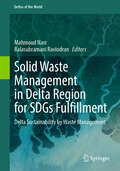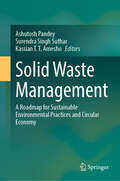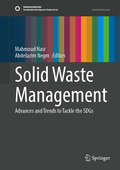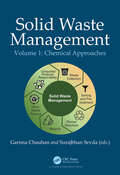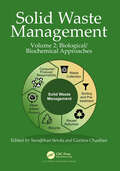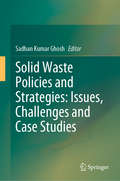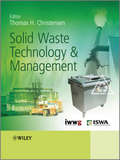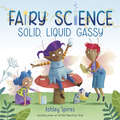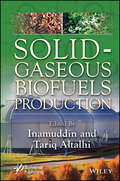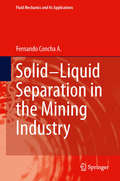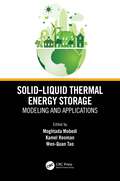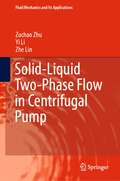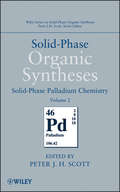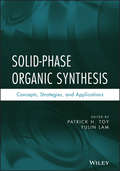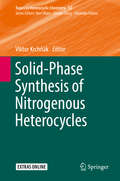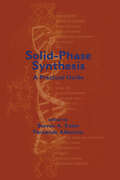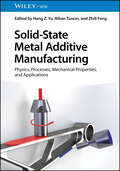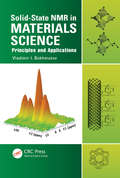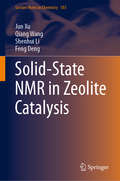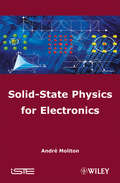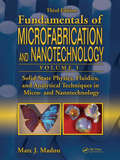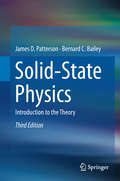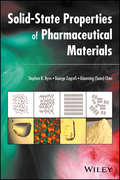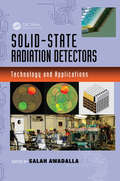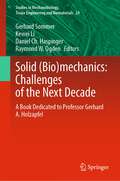- Table View
- List View
Solid Waste Management in Delta Region for SDGs Fulfillment: Delta Sustainability by Waste Management (Deltas of the World)
by Balasubramani Ravindran Mahmoud Nasr“This book offers a comprehensive exploration of sustainable solid waste management practices in delta regions worldwide. With attention to detail, this work presents a systematic review, illuminating case studies, original research, and insightful meta-analyses tailored to address the unique challenges faced by delta environments. Home to over half a billion people, or approximately 7% of the global population, delta regions are dynamic ecological and social landscapes, despite accounting for only 1% of the world's land area. Yet, they play a pivotal role in national economies. Given the significant size and density of populations in these regions, understanding solid waste generation patterns, trends, and impacts is essential for global sustainability efforts. By focusing on deltaic regions, we aim to provide essential insights into effective policy planning and advancements in social and ecological sustainability. Explore a diverse array of topics, including the bioconversion of food waste into environmentally friendly compounds, sustainable production and disposal practices to address water quality concerns, and innovative waste management applications to combat channel clogging and flooding in delta districts. Delve into best practices for managing climate-related flood risks, addressing urban responses, and tackling environmental pollution associated with unmanaged waste disposal in delta catchments. Additionally, gain valuable insights into the regulatory framework guiding waste management practices, particularly in delta regions facing significant plastic pollution challenges. This book navigates the complexities of solid waste management in delta regions, paving the way for a more sustainable future.”
Solid Waste Management: A Roadmap for Sustainable Environmental Practices and Circular Economy
by Ashutosh Pandey Surendra Singh Suthar Kassian T. T. AmeshoSolid waste management has become a significant global concern, particularly in maintaining and preserving value in solid waste resources. Local socio-economic disparities create various demands for sustainable solid waste management, leading to a wide range of waste reduction, recovery, and recycling solutions. This highlights the importance of accurately interpreting new policies within the framework of the circular economy. Accordingly, the title of this book is Solid Waste Management: Sustainable Environmental Practices and the Circular Economy. This book contains chapters on contemporary research that focuses on innovative technologies, concepts, models, and tools for sustainable solid waste management, as sustainable environmental practices and the circular economy have garnered increasing interest. This volume seeks to enhance scientific potential in the field of sustainable waste management by publishing cutting-edge theoretical and experimental studies that will advance our understanding of green technologies for sustainable solid waste management systems, aligned with the principles of sustainable environmental practices and the circular economy.
Solid Waste Management: Advances and Trends to Tackle the SDGs (Sustainable Development Goals Series)
by Abdelazim Negm Mahmoud NasrThis book covers the latest advances in sustainable waste management and focuses on its implementation to mitigate water and air pollution, recycle and reuse raw material, and refine valuable metals. In this book, readers will learn about organic waste treatment, emerging waste management techniques, and the transformation of waste into value-added products. Particular attention is given to environmental sustainability and how we can better achieve it through innovative and responsible waste management practices. Divided into 10 chapters, the book outlines a wide range of topics such as the sustainable management of food wastes through cavitation-assisted conversion, rapid bioconversion of animal meat waste into compost using black soldier fly larvae, thermoluminescence properties of combustion-synthesized nanomaterials and their applications for achieving Sustainable Development Goals, and the creative reuse of plastic waste with a case study by Ghanaian artists. Expert contributors uncover new methods and approaches to waste management that invite readers to think critically about the current practices and their impact on the environment. In addition to these discussions, the work explores the challenges of environmental health in waste management for peri-urban areas. This book provides a unique blend of theoretical perspectives and practical case studies that will enrich the understanding of sustainable waste management, and it equips readers with the knowledge needed to contribute to a more sustainable future. The book is an invaluable resource for researchers in the field of environmental science, students at all levels studying sustainability and waste management, and practitioners working in industry.
Solid Waste Management: Chemical Approaches, Volume 1
by Surajbhan Sevda Garima Chauhan‘Waste’ is generally identified as goods or material that are perceived to be mostly valueless. However, objects that are perceived to be waste based on consumers’ object valuation can be redefined to create value. This requires a multitude of efforts using different strategies in waste prevention and management. This book is an edited collection of various chemical approaches used for valorization of solid wastes, particularly, waste electrical and electronic equipment, plastic waste, and agro-residue waste, that provide research insights into the concept "waste-to-energy". Covering a variety of interdisciplinary topics on waste treatment and resource recovery makes the book one for all that serves as an excellent reading material for engineers, science scholars, entrepreneurs, and organizations who are working in the field of waste management.
Solid Waste Management: Volume 2: Biological/Biochemical Approaches
by Surajbhan Sevda Garima ChauhanWaste materials in the solid form tend to be bulky and difficult to handle and transport. Its management could happen through physical, thermal, chemical or biological processing stages, with the exact sequence of and their operational optima being decided by the waste composition. In recent years, energy crisis and increased waste production have been undoubtedly major issues of concern. As we mentioned in the previous volume of this book, defining waste is crucial in terms of identifying the most adequate approach to recycle or recover resources from the waste. Various chemical, biochemical, and biological approaches are being investigated widely by researchers for waste valorization. Volume 2 of this book brings together the leading researchers working on solid waste management using biological and biochemical approaches.
Solid Waste Policies and Strategies: Issues, Challenges and Case Studies
by Sadhan Kumar GhoshThe book focuses on the challenges faced by urban areas in the context of handling waste in an environmentally and socially acceptable manner. It also discusses effective waste management approaches, which differ according to culture, climate, and socio-economic variables, as well as institutional volume. Presenting selected, high-quality papers from IconSWM 2018, the book explores a number of waste management methods with the help of case studies.
Solid Waste Technology and Management
by Thomas ChristensenThe collection, transportation and subsequent processing of waste materials is a vast field of study which incorporates technical, social, legal, economic, environmental and regulatory issues. <P><P>Common waste management practices include landfilling, biological treatment, incineration, and recycling - all boasting advantages and disadvantages. Waste management has changed significantly over the past ten years, with an increased focus on integrated waste management and life-cycle assessment (LCA), with the aim of reducing the reliance on landfill with its obvious environmental concerns in favour of greener solutions. With contributions from more than seventy internationally known experts presented in two volumes and backed by the International Waste Working Group and the International Solid Waste Association, detailed chapters cover: Waste Generation and CharacterizationLife Cycle Assessment of Waste Management SystemsWaste MinimizationMaterial RecyclingWaste CollectionMechanical Treatment and SeparationThermal TreatmentBiological TreatmentLandfillingSpecial and Hazardous WasteSolid Waste Technology & Management is a balanced and detailed account of all aspects of municipal solid waste management, treatment and disposal, covering both engineering and management aspects with an overarching emphasis on the life-cycle approach.
Solid, Liquid, Gassy! (Fairy Science)
by Ashley SpiresFairy scientist Esther is experimenting with the water cycle in this enchanting STEM-and-magic-filled follow-up to Fairy Science, a picture book from the award-winning author-illustrator of The Most Magnificent Thing!When a pond dries up, fairy scientist Esther doesn't freeze under the pressure. She and her friends go full steam ahead for to make a scientific discovery! Bestselling author Ashley Spires (The Most Magnificent Thing) creates a charming primer to the water cycle. Includes an at-home water experiment for the budding scientist in your house!
Solid-Gaseous Biofuels Production
by Inamuddin Tariq AltalhiWritten by a team of industry experts and edited by one of the most prolific and well-respected engineering authors in the industry, this exciting new volume covers the latest processes, equipment, and applications for clean biofuel production. With renewable and alternative energy sources becoming more and more important, and the growth in percentage of the overall energy used, biofuels production is more important than ever and is a huge part of taking up the slack in the transition from fossil fuels. This volume covers many of the newest state-of-the art processes, trends, and changes in the industry, combining information from many disciplines to deliver have-to-have solutions for the engineer or scientist’s daily problems. Whether in the plant or in the classroom, this exciting new volume is a must-have for any engineer, scientist, student, or other industry professional working in biofuel production. Audience Engineers, scientists, faculty and students, and industry professionals working in the biofuel industry.
Solid-Liquid Separation in the Mining Industry
by Fernando Concha A.This book covers virtually all of the engineering science and technological aspects of separating water from particulate solids in the mining industry. It starts with an introduction to the field of mineral processing and the importance of water in mineral concentrators. The consumption of water in the various stages of concentration is discussed, as is the necessity of recovering the majority of that water for recycling. The book presents the fundamentals under which processes of solid-liquid separation are studied, approaching mixtures of discrete finely divided solid particles in water as a basis for dealing with sedimentation in particulate systems. Suspensions, treated as continuous media, provide the basis of sedimentation, flows through porous media and filtration. The book also considers particle aggregations, and thickening is analyzed in depth. Lastly, two chapters cover the fundamentals and application of rheology and the transport of suspensions. This work is suitable for researchers and professionals in laboratories and plants, and can also serve as additional reading for graduate courses on solid liquid separation as well as for advanced undergraduate and graduate level students for courses of fluid mechanics, solid-liquid separation, thickening, filtration and transport of suspensions in tubes and channels.
Solid-Liquid Thermal Energy Storage: Modeling and Applications
by Moghtada MobediSolid–Liquid Thermal Energy Storage: Modeling and Applications provides a comprehensive overview of solid–liquid phase change thermal storage. Chapters are written by specialists from both academia and industry. Using recent studies on the improvement, modeling, and new applications of these systems, the book discusses innovative solutions for any potential drawbacks. This book: Discusses experimental studies in the field of solid–liquid phase change thermal storage Reviews recent research on phase change materials Covers various innovative applications of phase change materials (PCM) on the use of sustainable and renewable energy sources Presents recent developments on the theoretical modeling of these systems Explains advanced methods for enhancement of heat transfer in PCM This book is a reference for engineers and industry professionals involved in the use of renewable energy systems, energy storage, heating systems for buildings, sustainability design, etc. It can also benefit graduate students taking courses in heat transfer, energy engineering, advanced materials, and heating systems.
Solid-Liquid Two-Phase Flow in Centrifugal Pump (Fluid Mechanics and Its Applications #136)
by Yi Li Zuchao Zhu Zhe LinThis book conducts a systematic study on internal flow characteristics and performance of centrifugal pump for solid–liquid mixed transportation. First, the applicability of the computational model for two-phase flow is analyzed. Then the relationship between the two-phase flow characteristics and wall wear in the pipeline is revealed. And the flow characteristics in centrifugal pumps are analyzed in relation to conveying performance and wall wear. Finally, the engineering application calculation of the mixed transportation pump with different impeller structures is carried out. The target audience of this book is researchers who perform calculations and engineering applications of solid–liquid two-phase pumps.This book considers the influence of the particle size on the force magnitude of the particles and analyzes the applicability of different solid–liquid two-phase calculation models. Considering the different motion trajectories of particles colliding with dry wall, wet wall, stationary wall, and moving wall, visual experiments are used to study the collision rebound model of different walls. The collision rebound model is applied to the numerical simulation of solid–liquid mixed transport.
Solid-Phase Organic Syntheses, Solid-Phase Palladium Chemistry
by Peter J. ScottIntegrates solid-phase organic synthesis with palladium chemistryThe Wiley Series on Solid-Phase Organic Syntheses keeps researchers current with major accomplishments in solid-phase organic synthesis, providing full experimental details. Following the validated, tested, and proven experimental procedures, readers can easily perform a broad range of complex syntheses needed for their own experiments and industrial applications. The series is conveniently organized into themed volumes according to the specific type of synthesis.This second volume in the series focuses on palladium chemistry in solid-phase synthesis, exploring palladium catalysts and reactions, procedures for preparation and utilization, ligands, and linker reactions. The first part of the volume offers a comprehensive overview of the field. Next, the chapters are organized into three parts:Part Two: Palladium-Mediated Solid-Phase Organic SynthesesPart Three: Immobilized Catalysts and LigandsPart Four: Palladium-Mediated Multifunctional CleavageEach chapter is written by one or more leading international experts in palladium chemistry. Their contributions reflect a thorough examination and review of the current literature as well as their own first-hand laboratory experience. References at the end of each chapter serve as a gateway to the field's literature.The introduction of palladium-mediated, cross-coupling reactions more than thirty years ago revolutionized the science of carbon-carbon bond formation. It has now become a cornerstone of today's synthetic organic chemistry laboratory. With this volume, researchers in organic and medicinal chemistry have access to a single resource that explains the fundamentals of palladium chemistry in solid-phase synthesis and sets forth clear, step-by-step instructions for conducting their own syntheses.
Solid-Phase Organic Synthesis
by Patrick H. Toy Yulin LamPresents both the fundamental concepts and the most recent applications in solid-phase organic synthesis With its emphasis on basic concepts, Solid-Phase Organic Synthesis guides readers through all the steps needed to design and perform successful solid-phase organic syntheses. The authors focus on the fundamentals of heterogeneous supports in the synthesis of organic molecules, explaining the use of a solid material to facilitate organic synthesis. This comprehensive text not only presents the fundamentals, but also reviews the most recent research findings and applications, offering readers everything needed to conduct their own state-of-the-art science experiments. Featuring chapters written by leading researchers in the field, Solid-Phase Organic Synthesis is divided into two parts: Part One, Concepts and Strategies, discusses the linker groups used to attach the synthesis substrate to the solid support, colorimetric tests to identify the presence of functional groups, combinatorial synthesis, and diversity-oriented synthesis. Readers will discover how solid-phase synthesis is currently used to facilitate the discovery of new molecular functionality. The final chapter discusses how using a support can change or increase reaction selectivity. Part Two, Applications, presents examples of the solid-phase synthesis of various classes of organic molecules. Chapters explore general asymmetric synthesis on a support, strategies for heterocyclic synthesis, and synthesis of radioactive organic molecules, dyes, dendrimers, and oligosaccharides. Each chapter ends with a set of conclusions that underscore the key concepts and methods. References in each chapter enable readers to investigate any topic in greater depth. With its presentation of basic concepts as well as recent findings and applications, Solid-Phase Organic Synthesis is the ideal starting point for students and researchers in organic, medicinal, and combinatorial chemistry who want to take full advantage of current solid-phase synthesis techniques.
Solid-Phase Synthesis of Nitrogenous Heterocycles (Topics in Heterocyclic Chemistry #52)
by Viktor KrchňákThe series Topics in Heterocyclic Chemistry presents critical reviews on present and future trends in the research of heterocyclic compounds. Overall the scope is to cover topics dealing with all areas within heterocyclic chemistry, both experimental and theoretical, of interest to the general heterocyclic chemistry community. The series consists of topic related volumes edited by renowned editors with contributions of experts in the field. All chapters from Topics in Heterocyclic Chemistry are published Online First with an individual DOI. In references, Topics in Heterocyclic Chemistry is abbreviated as Top Heterocycl Chem and cited as a journal.
Solid-Phase Synthesis: A Practical Guide
by Steven A. Kates Fernando AlbericioThis volume provides the information needed to synthesize peptides by solid-phase synthesis (SPS) - employing polymeric support (resins), anchoring linkages (handles), coupling reagents (activators), and protection schemes. It presents strategies for creating a wide variety of compounds for drug discovery and analyzes peptides, DNA, carbohydrates,
Solid-State Metal Additive Manufacturing: Physics, Processes, Mechanical Properties, and Applications
by Zhili Feng Hang Z. Yu Nihan TuncerSolid-State Metal Additive Manufacturing Timely summary of state-of-the-art solid-state metal 3D printing technologies, focusing on fundamental processing science and industrial applications Solid-State Metal Additive Manufacturing: Physics, Processes, Mechanical Properties, and Applications provides detailed and in-depth discussion on different solid-state metal additive manufacturing processes and applications, presenting associated methods, mechanisms and models, and unique benefits, as well as a detailed comparison to traditional fusion-based metal additive manufacturing. The text begins with a high-level overview of solid-state metal additive manufacturing with an emphasis on its position within the metal additive manufacturing spectrum and its potential for meeting specific demands in the aerospace, automotive, and defense industries. Next, each of the four categories of solid-state additive technologies—cold spray additive manufacturing, additive friction stir deposition, ultrasonic additive manufacturing, and sintering-based processes—is discussed in depth, reviewing advances in processing science, metallurgical science, and innovative applications. Finally, the future directions of these solid-state processes, especially the material innovation and artificial intelligence aspects, are discussed. Sample topics covered in Solid-State Metal Additive Manufacturing include: Physical processes and bonding mechanisms in impact-induced bonding and microstructures and microstructural evolution in cold sprayed materialsProcess fundamentals, dynamic microstructure evolution, and potential industrial applications of additive friction stir depositionMicrostructural and mechanical characterization and industrial applications of ultrasonic additive manufacturingPrinciples of solid-state sintering, binder jetting-based metal printing, and sintering-based metal additive manufacturing methods for magnetic materialsCritical issues inherent to melting and solidification, such as porosity, high residual stress, cast microstructure, anisotropic mechanical properties, and hot cracking Solid-State Metal Additive Manufacturing is an essential reference on the subject for academic researchers in materials science, mechanical, and biomedicine, as well as professional engineers in various manufacturing industries, especially those involved in building new additive technologies.
Solid-State NMR in Materials Science: Principles and Applications
by Vladimir I. BakhmutovSolid-state NMR is a powerful physical method widely applied in modern fundamental and applied science, medicine, and industry. Its role is particularly valuable in materials chemistry due to the capability of solid-state NMR to rapidly solve tasks connected with structural descriptions of complex systems on macro and/or molecular levels, and the i
Solid-State NMR in Zeolite Catalysis (Lecture Notes in Chemistry #103)
by Jun Xu Qiang Wang Shenhui Li Feng DengSolid-State NMR Characterization of Heterogeneous Catalysts and Catalytic Reactions provides a comprehensive account of state-of-the-art solid-state NMR techniques and the application of these techniques in heterogeneous catalysts and related catalytic reactions. It includes an introduction to the basic theory of solid-state NMR and various frequently used techniques. Special emphasis is placed on characterizing the framework and pore structure, active site, guest-host interaction, and synthesis mechanisms of heterogeneous catalysts using multinuclear one- and two-dimensional solid-sate NMR spectroscopy. Additionally, various in-situ solid-state NMR techniques and their applications in investigation of the mechanism of industrially important catalytic reactions are also discussed. Both the fundamentals and the latest research results are covered, making the book suitable as a reference guide for both experienced researchers in and newcomers to this field.Feng Deng is a Professor at Wuhan Institute of Physics and Mathematics, Chinese Academy of Sciences.
Solid-State Physics for Electronics
by Andre MolitonDescribing the fundamental physical properties of materials used in electronics, the thorough coverage of this book will facilitate an understanding of the technological processes used in the fabrication of electronic and photonic devices. The book opens with an introduction to the basic applied physics of simple electronic states and energy levels. Silicon and copper, the building blocks for many electronic devices, are used as examples. Next, more advanced theories are developed to better account for the electronic and optical behavior of ordered materials, such as diamond, and disordered materials, such as amorphous silicon. Finally, the principal quasi-particles (phonons, polarons, excitons, plasmons, and polaritons) that are fundamental to explaining phenomena such as component aging (phonons) and optical performance in terms of yield (excitons) or communication speed (polarons) are discussed.
Solid-State Physics, Fluidics, and Analytical Techniques in Micro- and Nanotechnology
by Marc J. MadouProviding a clear theoretical understanding of MEMS and NEMS, Solid-State Physics, Fluidics, and Analytical Techniques in Micro- and Nanotechnology focuses on nanotechnology and the science behind it, including solid-state physics. It provides a clear understanding of the electronic, mechanical, and optical properties of solids relied on in integra
Solid-State Physics: Introduction To The Theory
by James D. Patterson Bernard C. BaileyThis book teaches solid state physics in a comprehensive way, covering all areas. It begins with three broad topics: how and why atoms bind together to form solids, lattice vibrations and phonons, and electrons in solids. It then applies this knowledge to interactions, especially those between electrons and phonons, metals, the Fermi surface and alloys, semiconductors, magnetism, superconductivity, dielectrics and ferroelectrics, optical properties, defects, layered materials, quantum Hall effect, mesoscopics, nanophysics and soft condensed matter. Further important topics of the book are the evolution of BEC to BCS phenomena, conducting polymers, graphene, iron pnictide superconductors, light emitting diodes, N-V centers, nanomagnetism, negative index of refraction, optical lattices, phase transitions, phononics, photonics, plasmonics, quantum computing, solar cells, spin Hall effect and spintronics. <P><P> In this 3rd edition, topics such as topological insulators, quantum computing, Bose–Einstein transitions, highly correlated electron systems and several others have been added. New material on magnetism in solids, as well as a discussion of semiconductors and a changed set of problems with solutions, are also included. The book also discusses “folk theorems” to remind readers of the essence of the physics without mathematics, and includes 90 mini-biographies of prominent solid state physicists of the past and present to put a human face on the subject. An extensive solutions manual rounds out the book.
Solid-State Properties of Pharmaceutical Materials
by Stephen R. Byrn George Zografi Xiaoming Sean ChenPresents a detailed discussion of important solid-state properties, methods, and applications of solid-state analysis Illustrates the various phases or forms that solids can assume and discussesvarious issues related to the relative stability of solid forms and tendencies to undergo transformation Covers key methods of solid state analysis including X-ray powder diffraction, thermal analysis, microscopy, spectroscopy, and solid state NMR Reviews critical physical attributes of pharmaceutical materials, mainly related to drug substances, including particle size/surface area, hygroscopicity, mechanical properties, solubility, and physical and chemical stability Showcases the application of solid state material science in rational selection of drug solid forms, analysis of various solid forms within drug substance and the drug product, and pharmaceutical product development Introduces appropriate manufacturing and control procedures using Quality by Design, and other strategies that lead to safe and effective products with a minimum of resources and time
Solid-State Radiation Detectors: Technology and Applications (Devices, Circuits, and Systems #41)
by SALAH AWADALLA AND KRZYSZTOF INIEWSKIIntegrating aspects of engineering, application physics, and medical science, Solid-State Radiation Detectors: Technology and Applications offers a comprehensive review of new and emerging solid-state materials-based technologies for radiation detection. Each chapter is structured to address the current advantages and challenges of each material and technology presented, as well as to discuss novel research and applications. Featuring contributions from leading experts in industry and academia, this authoritative text:Covers modern semiconductors used for radiation monitoringExamines CdZnTe and CdTe technology for imaging applications including three-dimensional capability detectorsHighlights interconnect technology for current pixel detectorsDescribes hybrid pixel detectors and their characterizationsTackles the integrated analog signal processing read-out front ends for particle detectorsConsiders new organic materials with direct bandgap for direct energy detectionSummarizes recent developments involving lanthanum halide and cerium bromide scintillatorsAnalyzes the potential of recent progress in the field of crystallogenesis, quantum dots, and photonics crystals toward a new concept of x- and gamma-ray detectors based on metamaterialsExplores position-sensitivity photomultipliers and silicon photomultipliers for scintillation crystalsSolid-State Radiation Detectors: Technology and Applications provides a valuable reference for engineers and scientists looking to enhance the performance of radiation detector technology for medical imaging and other applications.
Solid: A Book Dedicated to Professor Gerhard A. Holzapfel (Studies in Mechanobiology, Tissue Engineering and Biomaterials #24)
by Raymond W. Ogden Gerhard Sommer Kewei Li Daniel Ch. HaspingerThis book offers a comprehensive and timely overview of the latest developments in the field of biomechanics and extensive knowledge of tissue structure, function, and modeling. Gathering chapters written by authoritative scientists, it reports on a range of continuum and computational models of solids, and related experimental works, for biomechanical applications. It discusses cutting-edge advances such as constitutive modeling and computational simulation of biological tissues and organs under physiological and pathological conditions, and their mechanical characterization. It covers innovative studies on arteries, heart, valvular tissue, and thrombus, brain tumor, muscle, liver, kidney, and stomach, among others. Written in honor of Professor Gerhard A. Holzapfel, the book provides specialized readers with a thorough and timely overview of different types of modeling in biomechanics, and current knowledge about biological structures and function.
